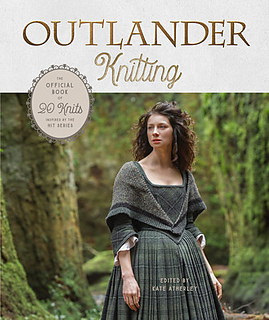patterns >  Outlander Knitting: The Official Book of 20 Knits Inspired by the Hit Series
Outlander Knitting: The Official Book of 20 Knits Inspired by the Hit Series
> Revirescit





Revirescit
This tea cozy plays with some of the symbols of the Jacobite movement, in which Claire and Jamie are reluctantly but inextricably caught up.
One of the most common symbols of the movement was the oak leaf and acorns. The oak had long been a symbol of the Stuarts, and of the Restoration. Charles II (brother and predecessor of Bonnie Prince Charlie’s grandfather, James II & VII) reportedly hid in an oak tree at Boscobel House during the English Civil War, which became famous as “The Royal Oak”, namesake of many ships, pubs, songs, and tales.
In the Jacobite uprising, the image of withered or autumnal oak leaves was often accompanied by the Latin motto “revirescit”, which means “it revives”. This symbol of restoration and regeneration had obvious significance to those hoping to restore the Stuarts to the throne, and yet, like most subversive symbols, it could easily be explained away as innocent imagery.
The cozy is worked in the round, in stranded knitting. Wedge-shaped gussets feature the acorns, while the main panels feature the oak leaves, with a subtle tartan effect in the background that helps to prevent the long floats that would otherwise cause catching or puckering in the knitting. Ribbing at the bottom snugs the cozy in and prevents the edge from rolling.
SKILLS REQUIRED
- Knit & purl
- Cast on
- Three-needle bind-off
- Decreasing
- Working in the round on circular needles
- Working small circumferences in the round on DPNs/with magic loop/with two circulars
- Working from charts
- Stranded colourwork
- Weaving in ends
MATERIALS
Yarn
Trendsetter Yarns Wish (75% Organic Wool, 25% Polyamide; 165 yds/150 per 1.76 oz/50 g skein)
MC color 129 Charcoal; 1 skein
CC1 color 162 Honey; 1 skein
Substitution Notes: A woolly DK weight yarn with plenty of loft to create effective insulation is key. It does not need to be next-to-the-skin soft. The background colour is dark (to camouflage tea stains!) and the contrast colour can be golden-brown like ageing oak leaves, or perhaps a vibrant spring green to represent regrowth. Trendsetter Wish is also gently heathered and tweedy, which adds a traditional flavour; this pattern is best suited to solid or heathered colours, rather than tonal or multi-tonal yarns.
Needles
3.5 mm/US 4 and 4 mm/US 6 needles (or size to achieve gauge) for working small circumference in the round: traditional or flexible DPNs, 1 long circular, 2 short circulars
Notions
Yarn needle
GAUGE
19 sts/30 rounds = 4 inches square in stockinette stitch using #mm/US # needles
23 sts/27 rounds = 4 inches square in pattern stitch using 4 mm/US 6 needles
SIZE INFORMATION
Sizes
4-cup teapot (6-cup teapot).
Finished Measurements
Height: 7.5” (8”)
Circumference at hem: 23” (29.5”)
Note: the cozy covers the handle and spout entirely, so measure the total circumference of the pot including those protrusions.
PATTERN NOTES
The cast on and ribbing are worked on the smaller sized needle, and then the larger needles are used for the colourwork. The cozy is finished with a three-needle bind-off, and the smaller needle can be used as the third needle for this. When working Chart A (the front/back panel), work the first 38 stitches and then work either the section with the blue border (4-cup size) or the section with the red border (6-cup size).
As with any figurative motif in stranded knitting, there are some unavoidable long runs of a single colour. For up to 4 stitches of a single colour, basic stranded knitting is fine; for runs of 5 or more stitches, it is important to catch the unused strand on the inside of the work to avoid long floats that will catch. Be sure to keep floats relaxed or the finished knitting will have a tendency to pucker. Some knitters prefer to do colourwork inside-out in order to keep the floats loose; experiment and see what works best for you.
The shape of the cozy is meant to accommodate the traditional Brown Betty teapot in 4- and 6-cup sizes, but teapots are endlessly varied. For taller or shorter pots, the length of the ribbing at the bottom can be adjusted; for narrower pots, the gusset (Chart B) can be eliminated; and for wider pots, the gusset (including the vertical stripes that define it) can be made thicker. The weight and gauge of the yarn will also impact the finished size; worked in laceweight on the tiniest sock needles, this could be an egg cozy rather than a tea cozy! Changes in gauge will, of course, impact the yardage required.
75 projects
stashed
100 times
- First published: October 2020
- Page created: October 26, 2020
- Last updated: May 29, 2021 …
- visits in the last 24 hours
- visitors right now




